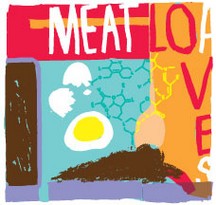The Joy of Cooking Chemistry
- Share
- Tweet
- Pin
- Share

Illustration by Ryan Miller.
My mama, as her mama, had certain folk attachments when it came to cooking and kitchen sayings. Potatoes ought not be boiled in a copper pan. Cutting the throats of chickens as practiced by slaughterhouses, leaves an after-taste but chopping the heads off does not. Boiling cabbage in the presence of a pregnant woman can induce labor, should not be done in the presence of those not full-term. My mama thought veal caused stomach ulcers. She believed pine needle tea cured mild fevers, headache and nausea. She would not put onions in milk gravy because one turned the other poisonous. My mama believed tender meat was for a hammer to do. Or a pressure cooker. She thought a good steak was pressure-cooked first, then pan-fried. In butter. My mama believed in butter. My mama believed in bread and butter. Fresh bread, with fresh well-salted butter, the butter and the bread of equal thickness. My dad had heart disease at 51. He was happy. This is chemistry.
Hervé This (pronounced Teess, he’s French) is a molecular gastronomist. A strange name for a cook, if some doubt there is such a thing as a molecular gastronomist. Perhaps to call This a culinary scientist. It was This who discovered the perfect temperature for cooking an egg, 65°C, the white coagulates, the yolk doesn’t. That the presence of an electric field improves the smoking of salmon, and when beating egg white add a small amount of cold water to increase the foam. Every month This adds a “cooking invention” to his Art et Science website of the French chef Pierre Gagnaire whose restaurant is at 6 rue Balzac in Paris.
While science and cooking have long been co-conspirators, even to think science began with cooking, the modern science of cooking gained almost legendary cachet as the result of a gathering of friends, scientists and chefs at a resort in Erice, Sicily. From 1992 to 2003, Hervé This organized meetings with Oxford physicist Nicholas Kurti. The participants cooked, ate and drank … for the record, four days’ worth; was at one of these meetings they coined the term molecular gastronomy.
Stock is a common kitchen word as well as a common practice. Stock is a mothering skill as it is an economic device. An alternative word is leftovers, debris perhaps would fit here. It is from “stock” that the economy of food increases, where the base of the meal, the ingredients were the previous day’s surplus, leftovers, miscellaneous. Stock was the half-peck of boiled potatoes that survived the previous evening supper. Sometimes the water the potatoes, the chicken, was boiled in. At its most economical, stock are the potato peelings, the carrot peelings, the core of the cabbage. What the molecular chemist recognizes as sugars, starches and various amino acids. It is for the chemist to wonder how these flavorants – sugars, starches, amino acids – are released. By inter-cellular solution or do you just simmer until the cell walls rupture? Two hours or twelve, at a hot fire or at a simmer? My mama favored twelve hours. This time lapse facilitated by the large cast iron wood stove that occupied a full quarter of the floor space in her kitchen. Propelled by red oak splints at about a quarter throttle setting of the damper that rendered the cast iron monolith with a mass density of 7800 kgm3, at a simmer of gastronomic velocity. Hervé This’ calculations do not include the cast iron stove, its mass thermal density or the efficiency of red oak firewood. My mama would have questioned his science.
The French word for instruction is precisioń. All cooks, my mama included, have a lot of precisions that make no sense other than an acute case of folklore. It is the nature of folklore, folk medicine, folk religion, that once a thing is done that way it becomes enshrined, the ritual is fixed. My mama would not mix mashed potatoes with cooked cabbage because she believed one made the other indigestible. My mama did not put chicken in sausage because it would lower your IQ, her proof was chickens already had a lower IQ. As a child I thought if only we ate cats we might have improved our IQ. However when it came to meatloaf our mama believed in free love. Meatloaf was a neater way of disposal than the garbage can. Meatloaf was camouflage, same as haggis. Any edible or inedible element could theoretically be incorporated in meatloaf and no one would be the wiser. Meatloaf could easily make sawdust edible. If you visited her kitchen my mama would give out her recipe for her Norwegian crumb-crust apple pie, her recipe for Argentine angel food cake, and for black Congo chocolate chip cookies. She would not give out her recipe for meatloaf under her Fifth Amendment right against self-incrimination, this as every evil-minded and efficient cook should know.
On our farm we used thousands of pairs of those yellow cotton work gloves priced by the dozen. I do remember wearing them out to the point of tattered gloves, oil-stained gloves, burned gloves. I don’t remember ever disposing of them or their remnants. Never was a glove carcass buried, thrown in the manure spreader, buried at sea, never a work glove stitched into a quilt pattern, which is a major oversight. They went somewhere. My guess is meatloaf. What mama called filler. What Hervé This would call “colle,” the chemical word for molecular valance bonding … a better word is glue. Somehow I guessed that. The Hervé This molecular recipe for puff pastry is ((S1/S2)0.5 σ ((W/O)/S3)0.5)σ729) … probably not the kind of thing you hand down to your kids.
